Organisational Behaviour: Culture, Power, and Motivation at Morrisons
VerifiedAdded on 2023/06/07
|12
|4256
|125
Report
AI Summary
This report provides an analysis of organisational behaviour within Morrisons, a major UK supermarket chain. It examines how the company's culture, politics, and power structures influence individual and team behaviour, and how these factors impact overall performance. The report evaluates content and process theories of motivation, including Maslow's hierarchy of needs and Herzberg's two-factor theory, and explores how motivational techniques can enable the effective achievement of organisational goals. Furthermore, it discusses the characteristics of effective versus ineffective teams and applies organisational behaviour concepts and philosophies within the specific context of Morrisons' business situation, considering the political and external forces affecting the company's culture and operations. The analysis aims to provide insights into improving employee engagement, productivity, and overall organisational success.
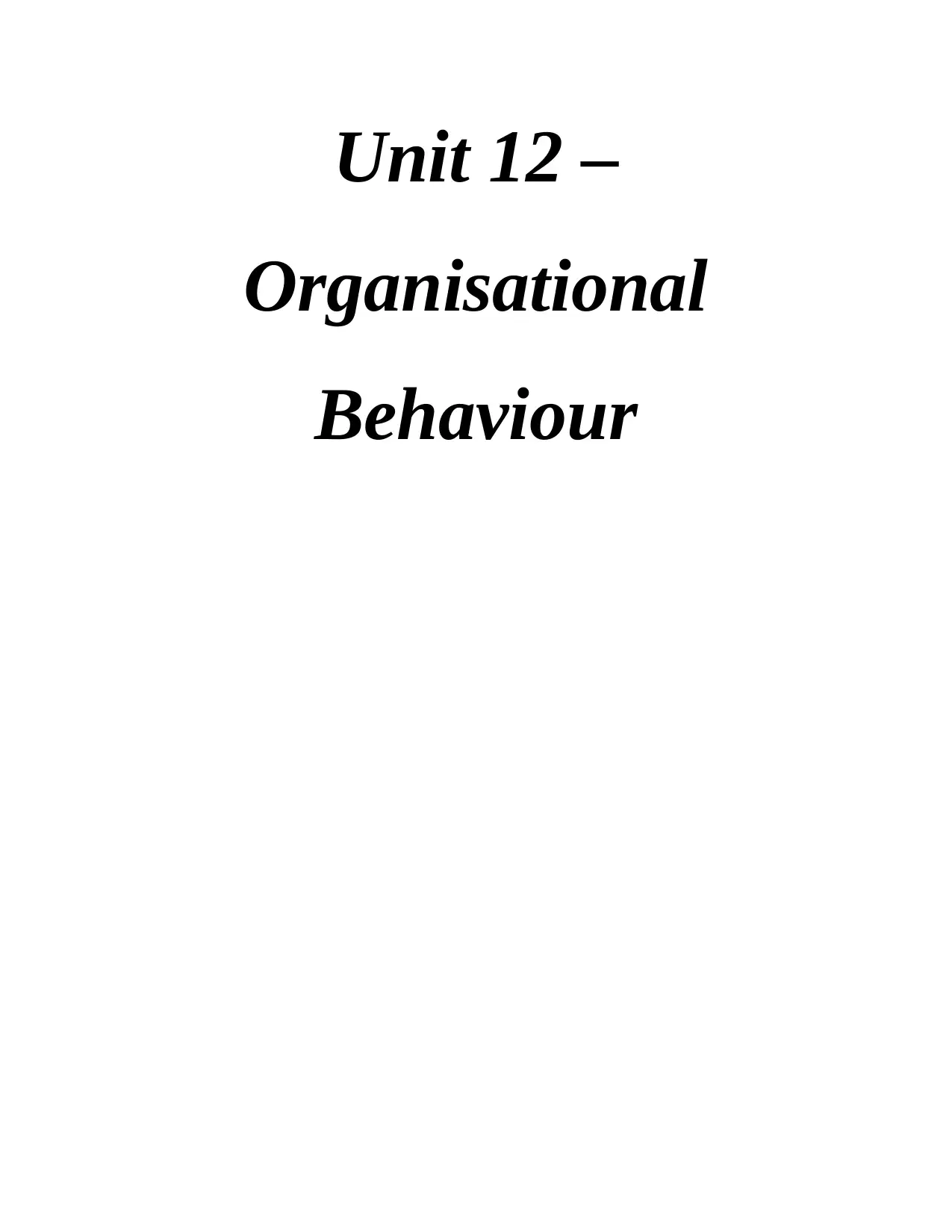
Unit 12 –
Organisational
Behaviour
Organisational
Behaviour
Paraphrase This Document
Need a fresh take? Get an instant paraphrase of this document with our AI Paraphraser
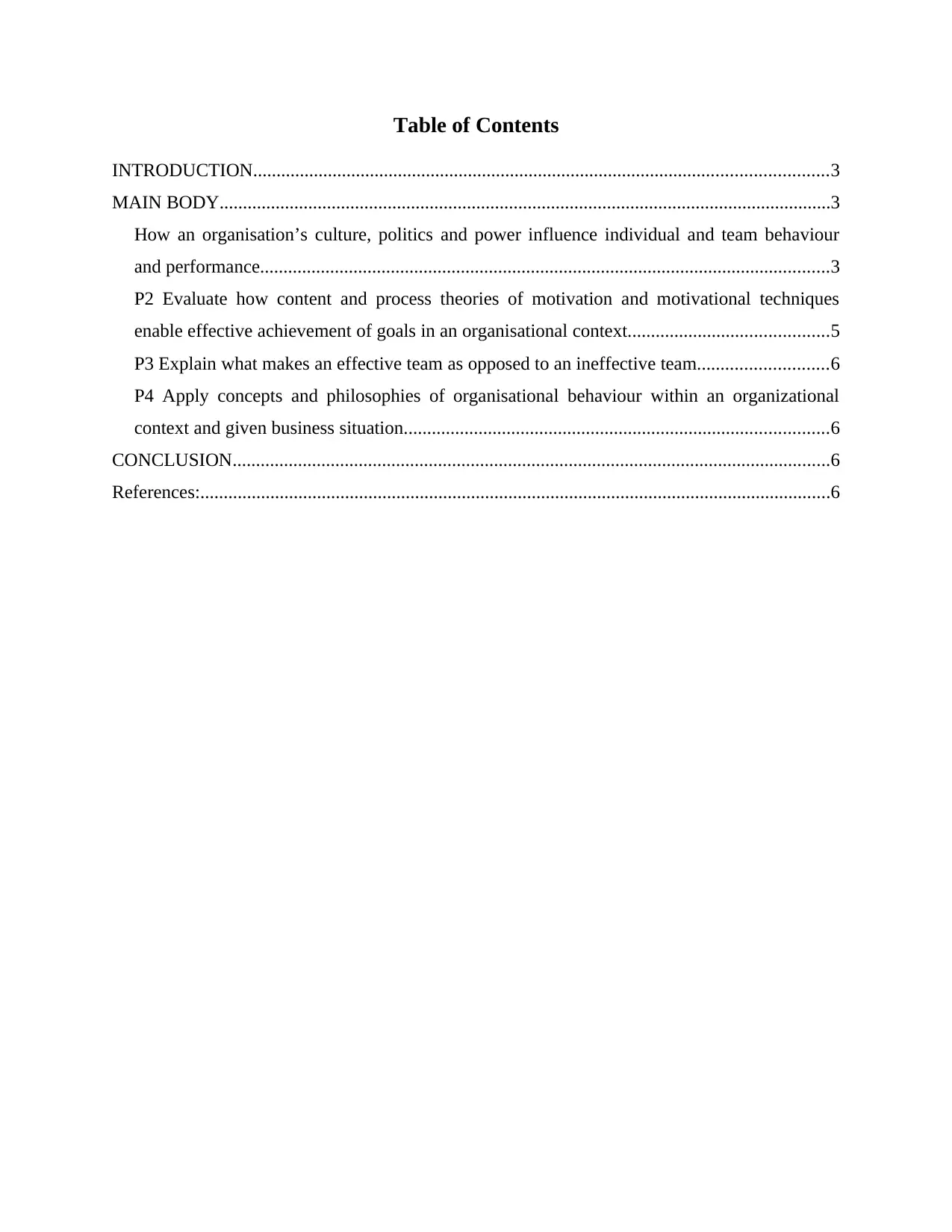
Table of Contents
INTRODUCTION...........................................................................................................................3
MAIN BODY...................................................................................................................................3
How an organisation’s culture, politics and power influence individual and team behaviour
and performance..........................................................................................................................3
P2 Evaluate how content and process theories of motivation and motivational techniques
enable effective achievement of goals in an organisational context...........................................5
P3 Explain what makes an effective team as opposed to an ineffective team............................6
P4 Apply concepts and philosophies of organisational behaviour within an organizational
context and given business situation...........................................................................................6
CONCLUSION................................................................................................................................6
References:.......................................................................................................................................6
INTRODUCTION...........................................................................................................................3
MAIN BODY...................................................................................................................................3
How an organisation’s culture, politics and power influence individual and team behaviour
and performance..........................................................................................................................3
P2 Evaluate how content and process theories of motivation and motivational techniques
enable effective achievement of goals in an organisational context...........................................5
P3 Explain what makes an effective team as opposed to an ineffective team............................6
P4 Apply concepts and philosophies of organisational behaviour within an organizational
context and given business situation...........................................................................................6
CONCLUSION................................................................................................................................6
References:.......................................................................................................................................6
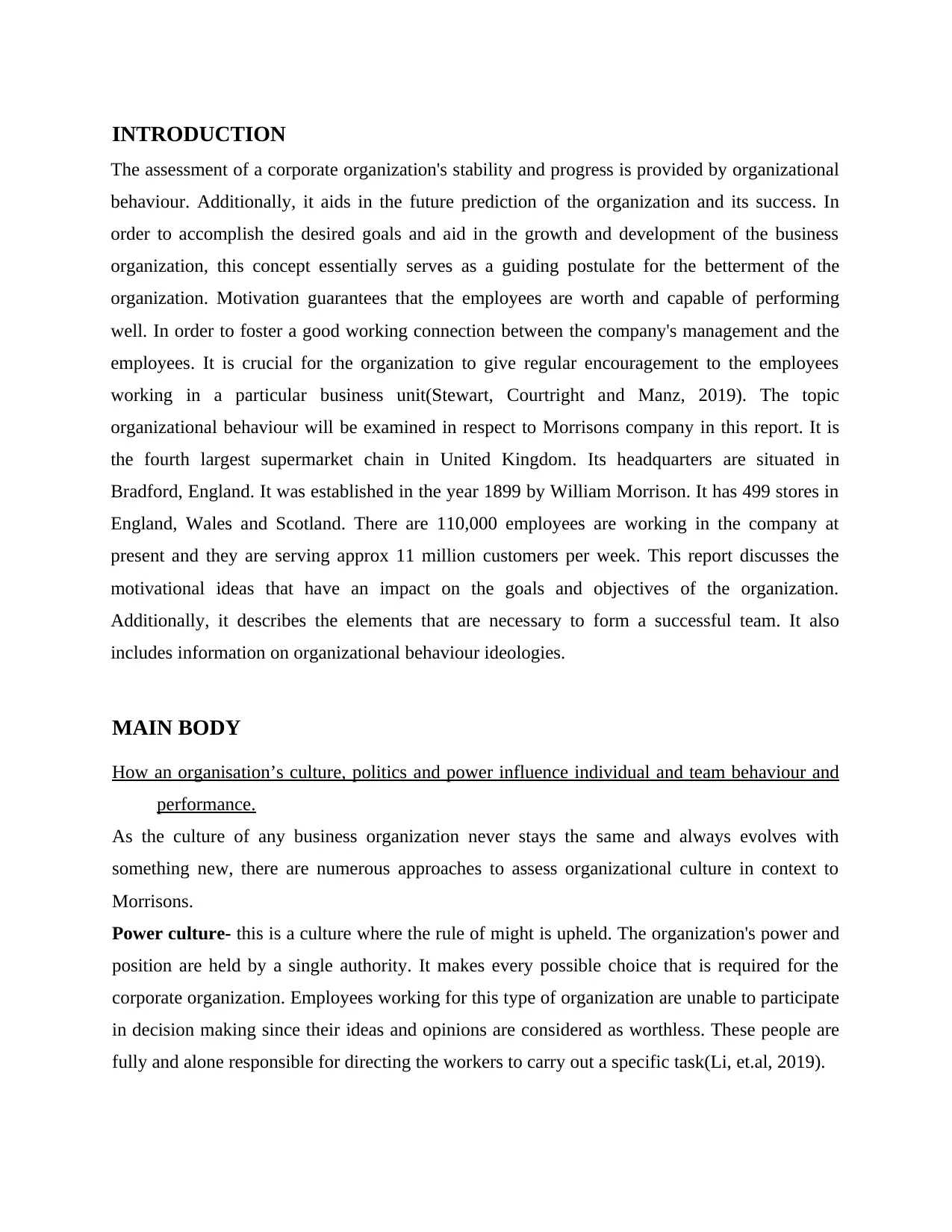
INTRODUCTION
The assessment of a corporate organization's stability and progress is provided by organizational
behaviour. Additionally, it aids in the future prediction of the organization and its success. In
order to accomplish the desired goals and aid in the growth and development of the business
organization, this concept essentially serves as a guiding postulate for the betterment of the
organization. Motivation guarantees that the employees are worth and capable of performing
well. In order to foster a good working connection between the company's management and the
employees. It is crucial for the organization to give regular encouragement to the employees
working in a particular business unit(Stewart, Courtright and Manz, 2019). The topic
organizational behaviour will be examined in respect to Morrisons company in this report. It is
the fourth largest supermarket chain in United Kingdom. Its headquarters are situated in
Bradford, England. It was established in the year 1899 by William Morrison. It has 499 stores in
England, Wales and Scotland. There are 110,000 employees are working in the company at
present and they are serving approx 11 million customers per week. This report discusses the
motivational ideas that have an impact on the goals and objectives of the organization.
Additionally, it describes the elements that are necessary to form a successful team. It also
includes information on organizational behaviour ideologies.
MAIN BODY
How an organisation’s culture, politics and power influence individual and team behaviour and
performance.
As the culture of any business organization never stays the same and always evolves with
something new, there are numerous approaches to assess organizational culture in context to
Morrisons.
Power culture- this is a culture where the rule of might is upheld. The organization's power and
position are held by a single authority. It makes every possible choice that is required for the
corporate organization. Employees working for this type of organization are unable to participate
in decision making since their ideas and opinions are considered as worthless. These people are
fully and alone responsible for directing the workers to carry out a specific task(Li, et.al, 2019).
The assessment of a corporate organization's stability and progress is provided by organizational
behaviour. Additionally, it aids in the future prediction of the organization and its success. In
order to accomplish the desired goals and aid in the growth and development of the business
organization, this concept essentially serves as a guiding postulate for the betterment of the
organization. Motivation guarantees that the employees are worth and capable of performing
well. In order to foster a good working connection between the company's management and the
employees. It is crucial for the organization to give regular encouragement to the employees
working in a particular business unit(Stewart, Courtright and Manz, 2019). The topic
organizational behaviour will be examined in respect to Morrisons company in this report. It is
the fourth largest supermarket chain in United Kingdom. Its headquarters are situated in
Bradford, England. It was established in the year 1899 by William Morrison. It has 499 stores in
England, Wales and Scotland. There are 110,000 employees are working in the company at
present and they are serving approx 11 million customers per week. This report discusses the
motivational ideas that have an impact on the goals and objectives of the organization.
Additionally, it describes the elements that are necessary to form a successful team. It also
includes information on organizational behaviour ideologies.
MAIN BODY
How an organisation’s culture, politics and power influence individual and team behaviour and
performance.
As the culture of any business organization never stays the same and always evolves with
something new, there are numerous approaches to assess organizational culture in context to
Morrisons.
Power culture- this is a culture where the rule of might is upheld. The organization's power and
position are held by a single authority. It makes every possible choice that is required for the
corporate organization. Employees working for this type of organization are unable to participate
in decision making since their ideas and opinions are considered as worthless. These people are
fully and alone responsible for directing the workers to carry out a specific task(Li, et.al, 2019).
⊘ This is a preview!⊘
Do you want full access?
Subscribe today to unlock all pages.

Trusted by 1+ million students worldwide
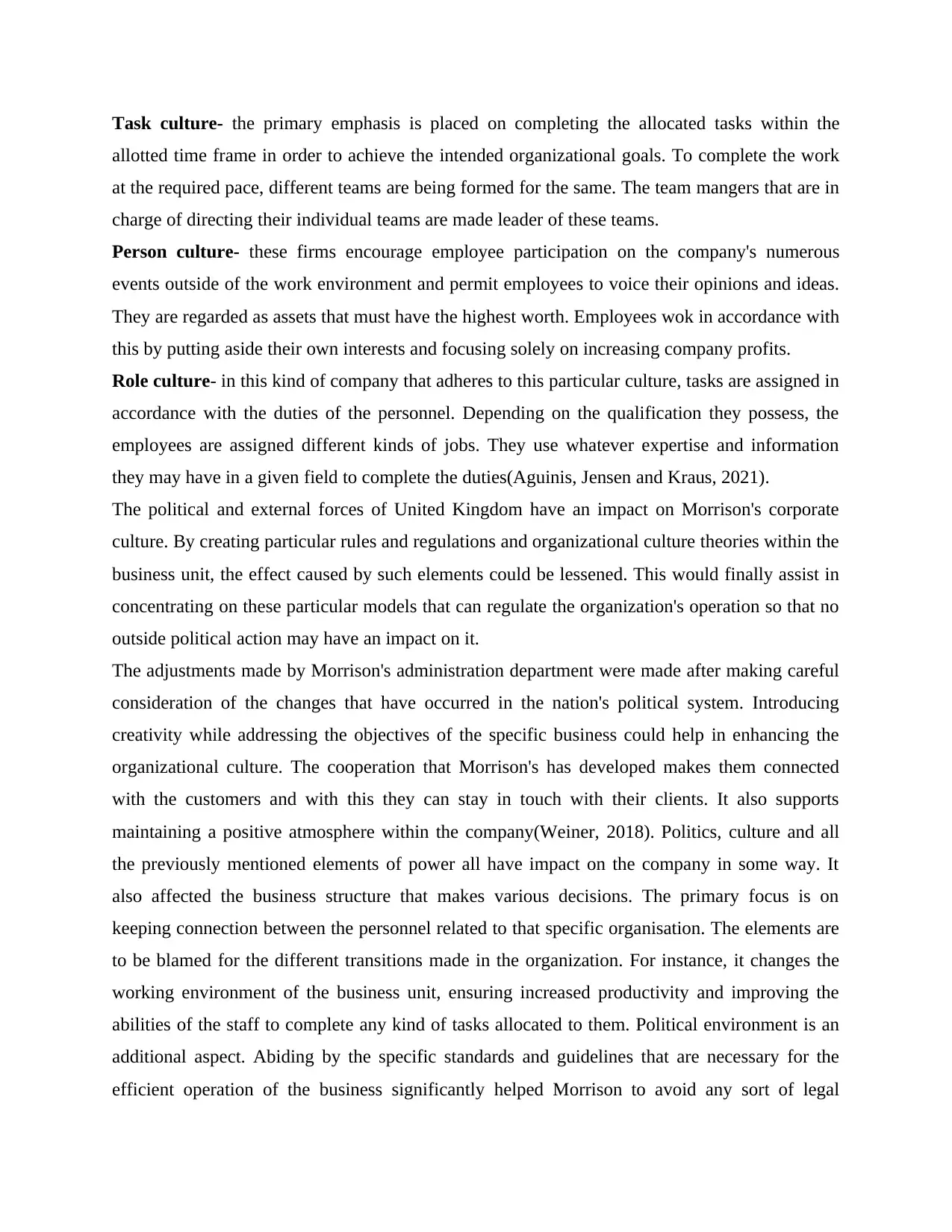
Task culture- the primary emphasis is placed on completing the allocated tasks within the
allotted time frame in order to achieve the intended organizational goals. To complete the work
at the required pace, different teams are being formed for the same. The team mangers that are in
charge of directing their individual teams are made leader of these teams.
Person culture- these firms encourage employee participation on the company's numerous
events outside of the work environment and permit employees to voice their opinions and ideas.
They are regarded as assets that must have the highest worth. Employees wok in accordance with
this by putting aside their own interests and focusing solely on increasing company profits.
Role culture- in this kind of company that adheres to this particular culture, tasks are assigned in
accordance with the duties of the personnel. Depending on the qualification they possess, the
employees are assigned different kinds of jobs. They use whatever expertise and information
they may have in a given field to complete the duties(Aguinis, Jensen and Kraus, 2021).
The political and external forces of United Kingdom have an impact on Morrison's corporate
culture. By creating particular rules and regulations and organizational culture theories within the
business unit, the effect caused by such elements could be lessened. This would finally assist in
concentrating on these particular models that can regulate the organization's operation so that no
outside political action may have an impact on it.
The adjustments made by Morrison's administration department were made after making careful
consideration of the changes that have occurred in the nation's political system. Introducing
creativity while addressing the objectives of the specific business could help in enhancing the
organizational culture. The cooperation that Morrison's has developed makes them connected
with the customers and with this they can stay in touch with their clients. It also supports
maintaining a positive atmosphere within the company(Weiner, 2018). Politics, culture and all
the previously mentioned elements of power all have impact on the company in some way. It
also affected the business structure that makes various decisions. The primary focus is on
keeping connection between the personnel related to that specific organisation. The elements are
to be blamed for the different transitions made in the organization. For instance, it changes the
working environment of the business unit, ensuring increased productivity and improving the
abilities of the staff to complete any kind of tasks allocated to them. Political environment is an
additional aspect. Abiding by the specific standards and guidelines that are necessary for the
efficient operation of the business significantly helped Morrison to avoid any sort of legal
allotted time frame in order to achieve the intended organizational goals. To complete the work
at the required pace, different teams are being formed for the same. The team mangers that are in
charge of directing their individual teams are made leader of these teams.
Person culture- these firms encourage employee participation on the company's numerous
events outside of the work environment and permit employees to voice their opinions and ideas.
They are regarded as assets that must have the highest worth. Employees wok in accordance with
this by putting aside their own interests and focusing solely on increasing company profits.
Role culture- in this kind of company that adheres to this particular culture, tasks are assigned in
accordance with the duties of the personnel. Depending on the qualification they possess, the
employees are assigned different kinds of jobs. They use whatever expertise and information
they may have in a given field to complete the duties(Aguinis, Jensen and Kraus, 2021).
The political and external forces of United Kingdom have an impact on Morrison's corporate
culture. By creating particular rules and regulations and organizational culture theories within the
business unit, the effect caused by such elements could be lessened. This would finally assist in
concentrating on these particular models that can regulate the organization's operation so that no
outside political action may have an impact on it.
The adjustments made by Morrison's administration department were made after making careful
consideration of the changes that have occurred in the nation's political system. Introducing
creativity while addressing the objectives of the specific business could help in enhancing the
organizational culture. The cooperation that Morrison's has developed makes them connected
with the customers and with this they can stay in touch with their clients. It also supports
maintaining a positive atmosphere within the company(Weiner, 2018). Politics, culture and all
the previously mentioned elements of power all have impact on the company in some way. It
also affected the business structure that makes various decisions. The primary focus is on
keeping connection between the personnel related to that specific organisation. The elements are
to be blamed for the different transitions made in the organization. For instance, it changes the
working environment of the business unit, ensuring increased productivity and improving the
abilities of the staff to complete any kind of tasks allocated to them. Political environment is an
additional aspect. Abiding by the specific standards and guidelines that are necessary for the
efficient operation of the business significantly helped Morrison to avoid any sort of legal
Paraphrase This Document
Need a fresh take? Get an instant paraphrase of this document with our AI Paraphraser
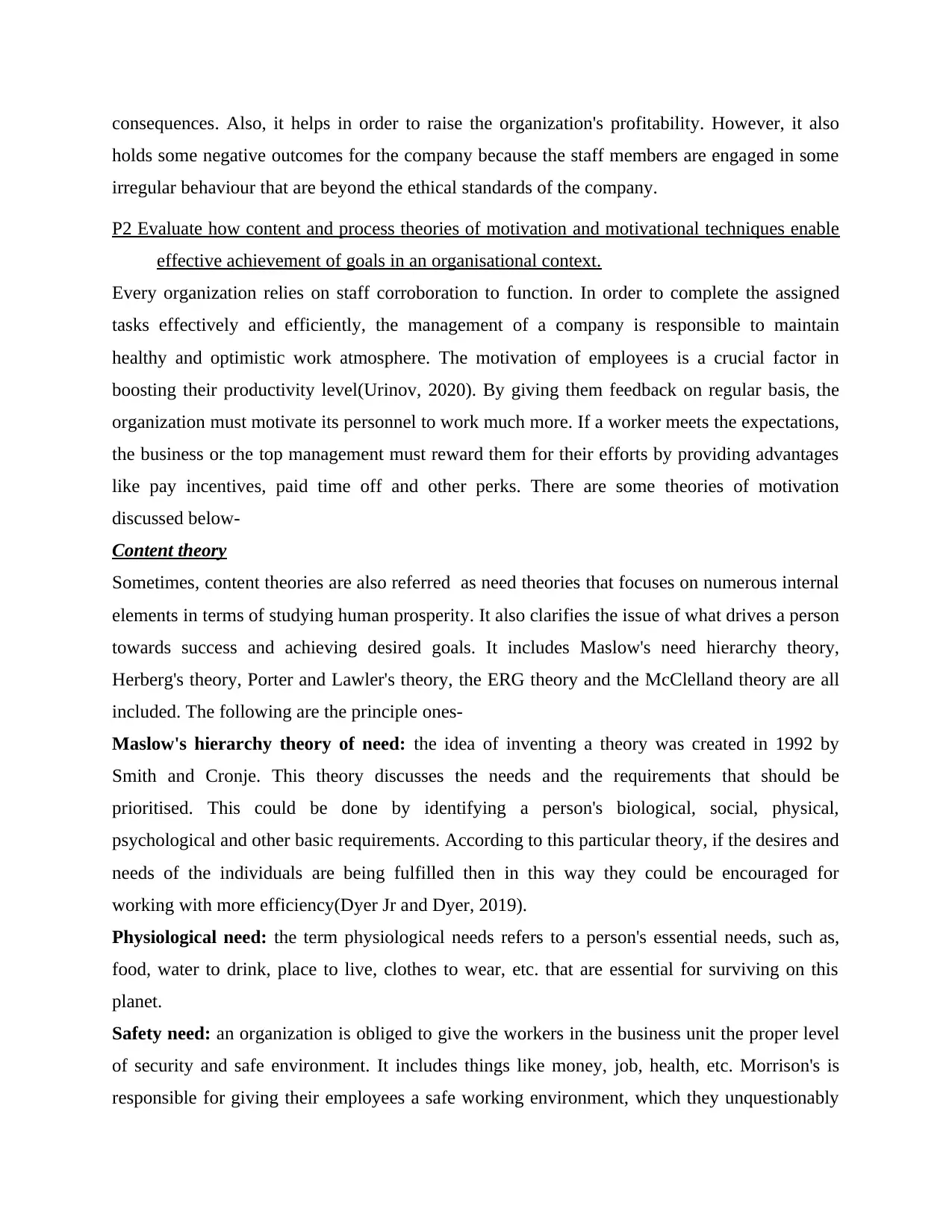
consequences. Also, it helps in order to raise the organization's profitability. However, it also
holds some negative outcomes for the company because the staff members are engaged in some
irregular behaviour that are beyond the ethical standards of the company.
P2 Evaluate how content and process theories of motivation and motivational techniques enable
effective achievement of goals in an organisational context.
Every organization relies on staff corroboration to function. In order to complete the assigned
tasks effectively and efficiently, the management of a company is responsible to maintain
healthy and optimistic work atmosphere. The motivation of employees is a crucial factor in
boosting their productivity level(Urinov, 2020). By giving them feedback on regular basis, the
organization must motivate its personnel to work much more. If a worker meets the expectations,
the business or the top management must reward them for their efforts by providing advantages
like pay incentives, paid time off and other perks. There are some theories of motivation
discussed below-
Content theory
Sometimes, content theories are also referred as need theories that focuses on numerous internal
elements in terms of studying human prosperity. It also clarifies the issue of what drives a person
towards success and achieving desired goals. It includes Maslow's need hierarchy theory,
Herberg's theory, Porter and Lawler's theory, the ERG theory and the McClelland theory are all
included. The following are the principle ones-
Maslow's hierarchy theory of need: the idea of inventing a theory was created in 1992 by
Smith and Cronje. This theory discusses the needs and the requirements that should be
prioritised. This could be done by identifying a person's biological, social, physical,
psychological and other basic requirements. According to this particular theory, if the desires and
needs of the individuals are being fulfilled then in this way they could be encouraged for
working with more efficiency(Dyer Jr and Dyer, 2019).
Physiological need: the term physiological needs refers to a person's essential needs, such as,
food, water to drink, place to live, clothes to wear, etc. that are essential for surviving on this
planet.
Safety need: an organization is obliged to give the workers in the business unit the proper level
of security and safe environment. It includes things like money, job, health, etc. Morrison's is
responsible for giving their employees a safe working environment, which they unquestionably
holds some negative outcomes for the company because the staff members are engaged in some
irregular behaviour that are beyond the ethical standards of the company.
P2 Evaluate how content and process theories of motivation and motivational techniques enable
effective achievement of goals in an organisational context.
Every organization relies on staff corroboration to function. In order to complete the assigned
tasks effectively and efficiently, the management of a company is responsible to maintain
healthy and optimistic work atmosphere. The motivation of employees is a crucial factor in
boosting their productivity level(Urinov, 2020). By giving them feedback on regular basis, the
organization must motivate its personnel to work much more. If a worker meets the expectations,
the business or the top management must reward them for their efforts by providing advantages
like pay incentives, paid time off and other perks. There are some theories of motivation
discussed below-
Content theory
Sometimes, content theories are also referred as need theories that focuses on numerous internal
elements in terms of studying human prosperity. It also clarifies the issue of what drives a person
towards success and achieving desired goals. It includes Maslow's need hierarchy theory,
Herberg's theory, Porter and Lawler's theory, the ERG theory and the McClelland theory are all
included. The following are the principle ones-
Maslow's hierarchy theory of need: the idea of inventing a theory was created in 1992 by
Smith and Cronje. This theory discusses the needs and the requirements that should be
prioritised. This could be done by identifying a person's biological, social, physical,
psychological and other basic requirements. According to this particular theory, if the desires and
needs of the individuals are being fulfilled then in this way they could be encouraged for
working with more efficiency(Dyer Jr and Dyer, 2019).
Physiological need: the term physiological needs refers to a person's essential needs, such as,
food, water to drink, place to live, clothes to wear, etc. that are essential for surviving on this
planet.
Safety need: an organization is obliged to give the workers in the business unit the proper level
of security and safe environment. It includes things like money, job, health, etc. Morrison's is
responsible for giving their employees a safe working environment, which they unquestionably
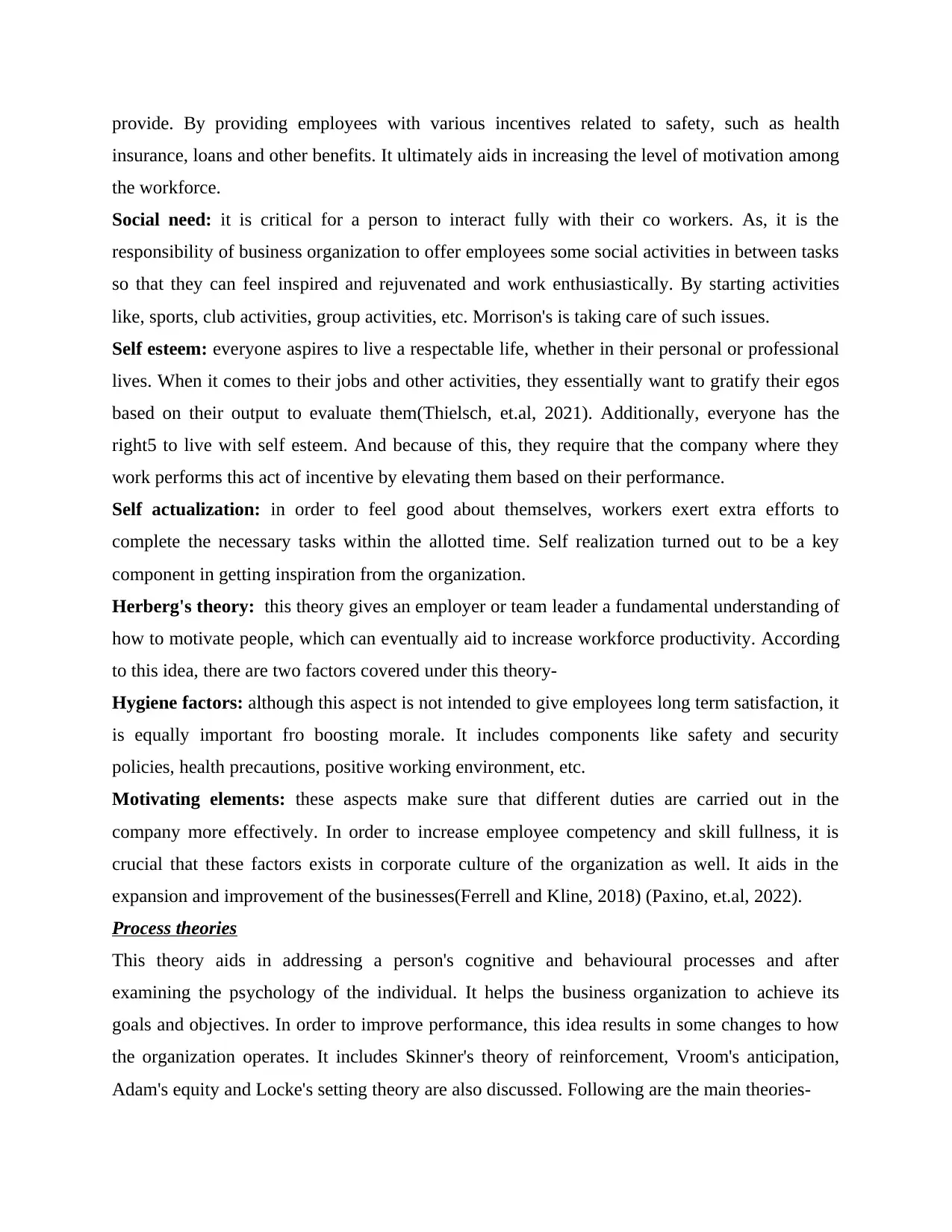
provide. By providing employees with various incentives related to safety, such as health
insurance, loans and other benefits. It ultimately aids in increasing the level of motivation among
the workforce.
Social need: it is critical for a person to interact fully with their co workers. As, it is the
responsibility of business organization to offer employees some social activities in between tasks
so that they can feel inspired and rejuvenated and work enthusiastically. By starting activities
like, sports, club activities, group activities, etc. Morrison's is taking care of such issues.
Self esteem: everyone aspires to live a respectable life, whether in their personal or professional
lives. When it comes to their jobs and other activities, they essentially want to gratify their egos
based on their output to evaluate them(Thielsch, et.al, 2021). Additionally, everyone has the
right5 to live with self esteem. And because of this, they require that the company where they
work performs this act of incentive by elevating them based on their performance.
Self actualization: in order to feel good about themselves, workers exert extra efforts to
complete the necessary tasks within the allotted time. Self realization turned out to be a key
component in getting inspiration from the organization.
Herberg's theory: this theory gives an employer or team leader a fundamental understanding of
how to motivate people, which can eventually aid to increase workforce productivity. According
to this idea, there are two factors covered under this theory-
Hygiene factors: although this aspect is not intended to give employees long term satisfaction, it
is equally important fro boosting morale. It includes components like safety and security
policies, health precautions, positive working environment, etc.
Motivating elements: these aspects make sure that different duties are carried out in the
company more effectively. In order to increase employee competency and skill fullness, it is
crucial that these factors exists in corporate culture of the organization as well. It aids in the
expansion and improvement of the businesses(Ferrell and Kline, 2018) (Paxino, et.al, 2022).
Process theories
This theory aids in addressing a person's cognitive and behavioural processes and after
examining the psychology of the individual. It helps the business organization to achieve its
goals and objectives. In order to improve performance, this idea results in some changes to how
the organization operates. It includes Skinner's theory of reinforcement, Vroom's anticipation,
Adam's equity and Locke's setting theory are also discussed. Following are the main theories-
insurance, loans and other benefits. It ultimately aids in increasing the level of motivation among
the workforce.
Social need: it is critical for a person to interact fully with their co workers. As, it is the
responsibility of business organization to offer employees some social activities in between tasks
so that they can feel inspired and rejuvenated and work enthusiastically. By starting activities
like, sports, club activities, group activities, etc. Morrison's is taking care of such issues.
Self esteem: everyone aspires to live a respectable life, whether in their personal or professional
lives. When it comes to their jobs and other activities, they essentially want to gratify their egos
based on their output to evaluate them(Thielsch, et.al, 2021). Additionally, everyone has the
right5 to live with self esteem. And because of this, they require that the company where they
work performs this act of incentive by elevating them based on their performance.
Self actualization: in order to feel good about themselves, workers exert extra efforts to
complete the necessary tasks within the allotted time. Self realization turned out to be a key
component in getting inspiration from the organization.
Herberg's theory: this theory gives an employer or team leader a fundamental understanding of
how to motivate people, which can eventually aid to increase workforce productivity. According
to this idea, there are two factors covered under this theory-
Hygiene factors: although this aspect is not intended to give employees long term satisfaction, it
is equally important fro boosting morale. It includes components like safety and security
policies, health precautions, positive working environment, etc.
Motivating elements: these aspects make sure that different duties are carried out in the
company more effectively. In order to increase employee competency and skill fullness, it is
crucial that these factors exists in corporate culture of the organization as well. It aids in the
expansion and improvement of the businesses(Ferrell and Kline, 2018) (Paxino, et.al, 2022).
Process theories
This theory aids in addressing a person's cognitive and behavioural processes and after
examining the psychology of the individual. It helps the business organization to achieve its
goals and objectives. In order to improve performance, this idea results in some changes to how
the organization operates. It includes Skinner's theory of reinforcement, Vroom's anticipation,
Adam's equity and Locke's setting theory are also discussed. Following are the main theories-
⊘ This is a preview!⊘
Do you want full access?
Subscribe today to unlock all pages.

Trusted by 1+ million students worldwide
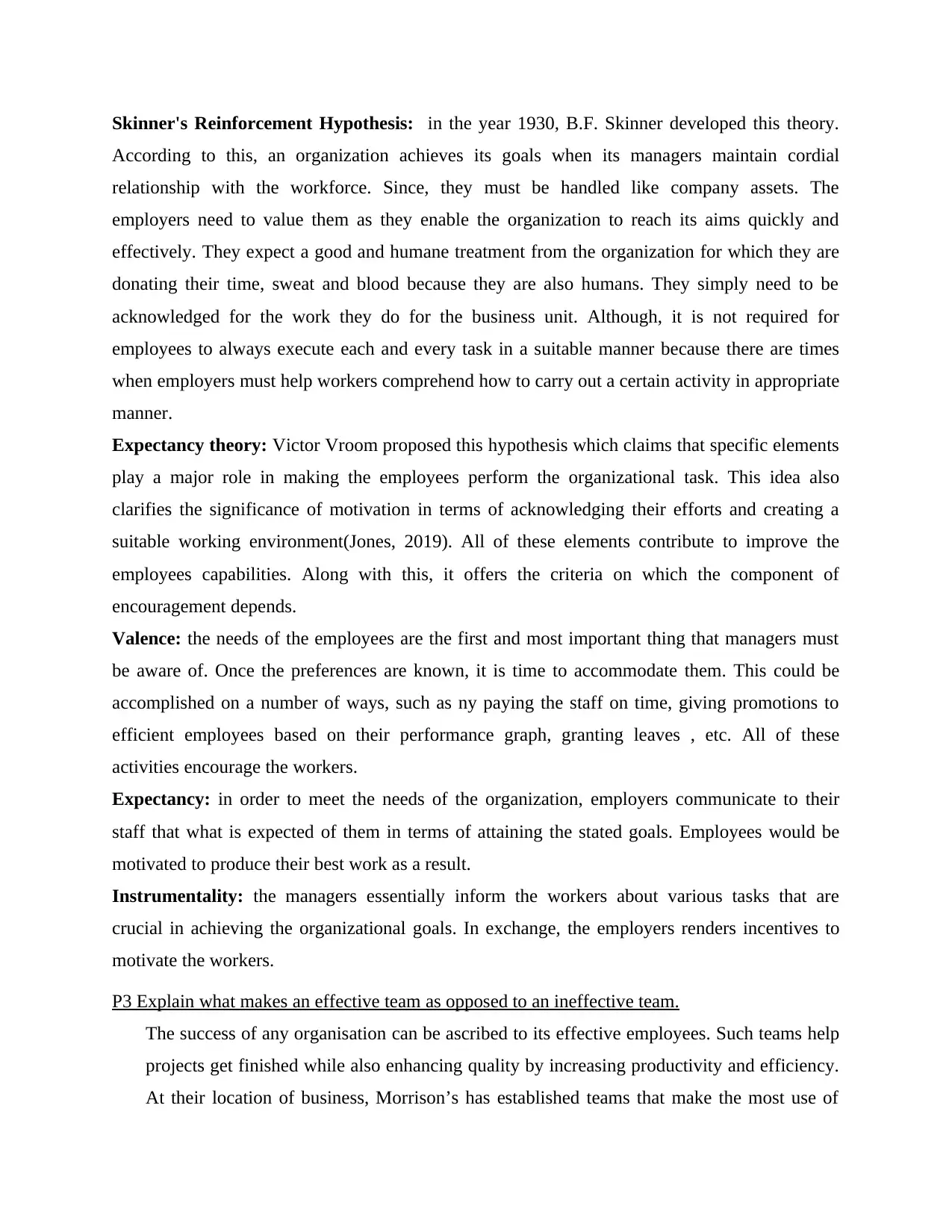
Skinner's Reinforcement Hypothesis: in the year 1930, B.F. Skinner developed this theory.
According to this, an organization achieves its goals when its managers maintain cordial
relationship with the workforce. Since, they must be handled like company assets. The
employers need to value them as they enable the organization to reach its aims quickly and
effectively. They expect a good and humane treatment from the organization for which they are
donating their time, sweat and blood because they are also humans. They simply need to be
acknowledged for the work they do for the business unit. Although, it is not required for
employees to always execute each and every task in a suitable manner because there are times
when employers must help workers comprehend how to carry out a certain activity in appropriate
manner.
Expectancy theory: Victor Vroom proposed this hypothesis which claims that specific elements
play a major role in making the employees perform the organizational task. This idea also
clarifies the significance of motivation in terms of acknowledging their efforts and creating a
suitable working environment(Jones, 2019). All of these elements contribute to improve the
employees capabilities. Along with this, it offers the criteria on which the component of
encouragement depends.
Valence: the needs of the employees are the first and most important thing that managers must
be aware of. Once the preferences are known, it is time to accommodate them. This could be
accomplished on a number of ways, such as ny paying the staff on time, giving promotions to
efficient employees based on their performance graph, granting leaves , etc. All of these
activities encourage the workers.
Expectancy: in order to meet the needs of the organization, employers communicate to their
staff that what is expected of them in terms of attaining the stated goals. Employees would be
motivated to produce their best work as a result.
Instrumentality: the managers essentially inform the workers about various tasks that are
crucial in achieving the organizational goals. In exchange, the employers renders incentives to
motivate the workers.
P3 Explain what makes an effective team as opposed to an ineffective team.
The success of any organisation can be ascribed to its effective employees. Such teams help
projects get finished while also enhancing quality by increasing productivity and efficiency.
At their location of business, Morrison’s has established teams that make the most use of
According to this, an organization achieves its goals when its managers maintain cordial
relationship with the workforce. Since, they must be handled like company assets. The
employers need to value them as they enable the organization to reach its aims quickly and
effectively. They expect a good and humane treatment from the organization for which they are
donating their time, sweat and blood because they are also humans. They simply need to be
acknowledged for the work they do for the business unit. Although, it is not required for
employees to always execute each and every task in a suitable manner because there are times
when employers must help workers comprehend how to carry out a certain activity in appropriate
manner.
Expectancy theory: Victor Vroom proposed this hypothesis which claims that specific elements
play a major role in making the employees perform the organizational task. This idea also
clarifies the significance of motivation in terms of acknowledging their efforts and creating a
suitable working environment(Jones, 2019). All of these elements contribute to improve the
employees capabilities. Along with this, it offers the criteria on which the component of
encouragement depends.
Valence: the needs of the employees are the first and most important thing that managers must
be aware of. Once the preferences are known, it is time to accommodate them. This could be
accomplished on a number of ways, such as ny paying the staff on time, giving promotions to
efficient employees based on their performance graph, granting leaves , etc. All of these
activities encourage the workers.
Expectancy: in order to meet the needs of the organization, employers communicate to their
staff that what is expected of them in terms of attaining the stated goals. Employees would be
motivated to produce their best work as a result.
Instrumentality: the managers essentially inform the workers about various tasks that are
crucial in achieving the organizational goals. In exchange, the employers renders incentives to
motivate the workers.
P3 Explain what makes an effective team as opposed to an ineffective team.
The success of any organisation can be ascribed to its effective employees. Such teams help
projects get finished while also enhancing quality by increasing productivity and efficiency.
At their location of business, Morrison’s has established teams that make the most use of
Paraphrase This Document
Need a fresh take? Get an instant paraphrase of this document with our AI Paraphraser
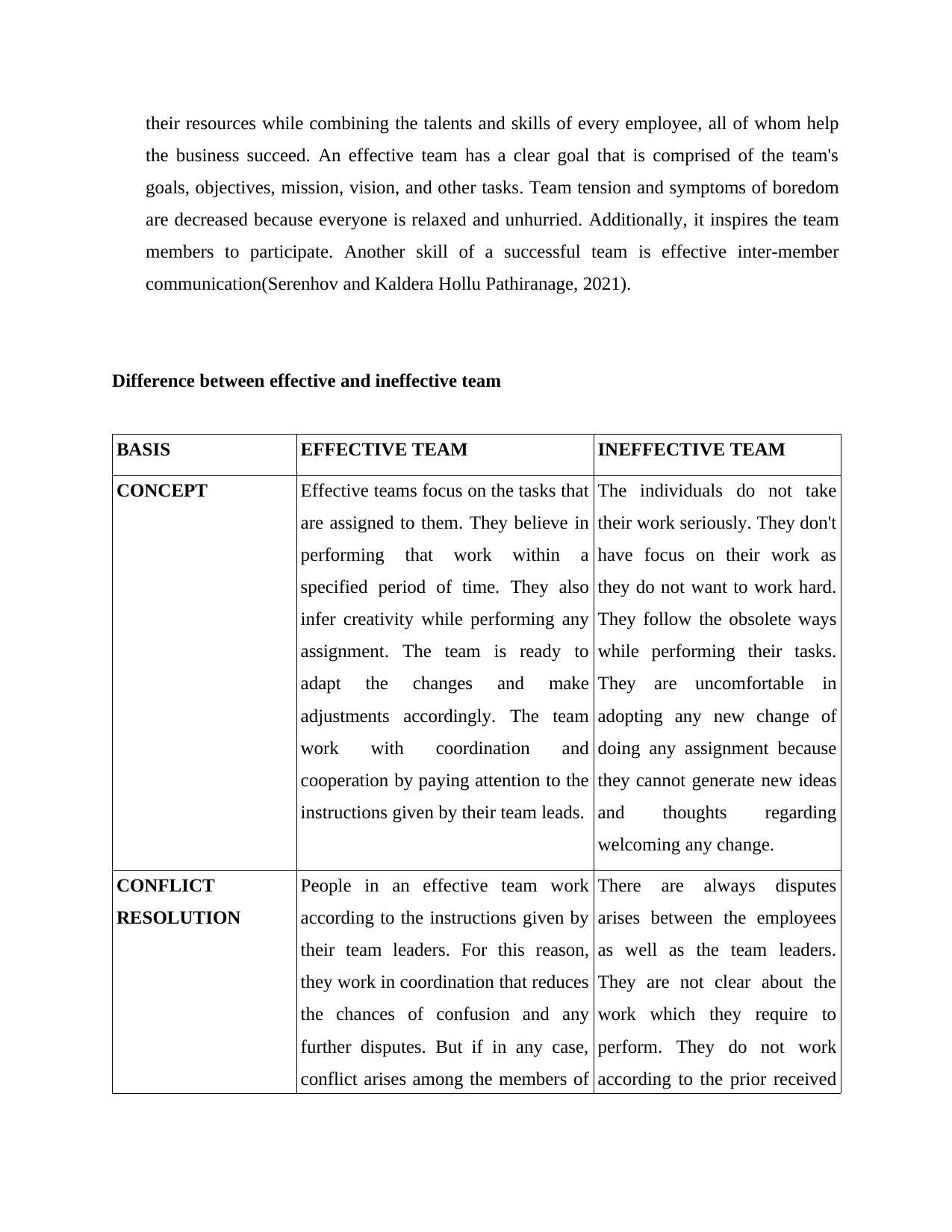
their resources while combining the talents and skills of every employee, all of whom help
the business succeed. An effective team has a clear goal that is comprised of the team's
goals, objectives, mission, vision, and other tasks. Team tension and symptoms of boredom
are decreased because everyone is relaxed and unhurried. Additionally, it inspires the team
members to participate. Another skill of a successful team is effective inter-member
communication(Serenhov and Kaldera Hollu Pathiranage, 2021).
Difference between effective and ineffective team
BASIS EFFECTIVE TEAM INEFFECTIVE TEAM
CONCEPT Effective teams focus on the tasks that
are assigned to them. They believe in
performing that work within a
specified period of time. They also
infer creativity while performing any
assignment. The team is ready to
adapt the changes and make
adjustments accordingly. The team
work with coordination and
cooperation by paying attention to the
instructions given by their team leads.
The individuals do not take
their work seriously. They don't
have focus on their work as
they do not want to work hard.
They follow the obsolete ways
while performing their tasks.
They are uncomfortable in
adopting any new change of
doing any assignment because
they cannot generate new ideas
and thoughts regarding
welcoming any change.
CONFLICT
RESOLUTION
People in an effective team work
according to the instructions given by
their team leaders. For this reason,
they work in coordination that reduces
the chances of confusion and any
further disputes. But if in any case,
conflict arises among the members of
There are always disputes
arises between the employees
as well as the team leaders.
They are not clear about the
work which they require to
perform. They do not work
according to the prior received
the business succeed. An effective team has a clear goal that is comprised of the team's
goals, objectives, mission, vision, and other tasks. Team tension and symptoms of boredom
are decreased because everyone is relaxed and unhurried. Additionally, it inspires the team
members to participate. Another skill of a successful team is effective inter-member
communication(Serenhov and Kaldera Hollu Pathiranage, 2021).
Difference between effective and ineffective team
BASIS EFFECTIVE TEAM INEFFECTIVE TEAM
CONCEPT Effective teams focus on the tasks that
are assigned to them. They believe in
performing that work within a
specified period of time. They also
infer creativity while performing any
assignment. The team is ready to
adapt the changes and make
adjustments accordingly. The team
work with coordination and
cooperation by paying attention to the
instructions given by their team leads.
The individuals do not take
their work seriously. They don't
have focus on their work as
they do not want to work hard.
They follow the obsolete ways
while performing their tasks.
They are uncomfortable in
adopting any new change of
doing any assignment because
they cannot generate new ideas
and thoughts regarding
welcoming any change.
CONFLICT
RESOLUTION
People in an effective team work
according to the instructions given by
their team leaders. For this reason,
they work in coordination that reduces
the chances of confusion and any
further disputes. But if in any case,
conflict arises among the members of
There are always disputes
arises between the employees
as well as the team leaders.
They are not clear about the
work which they require to
perform. They do not work
according to the prior received
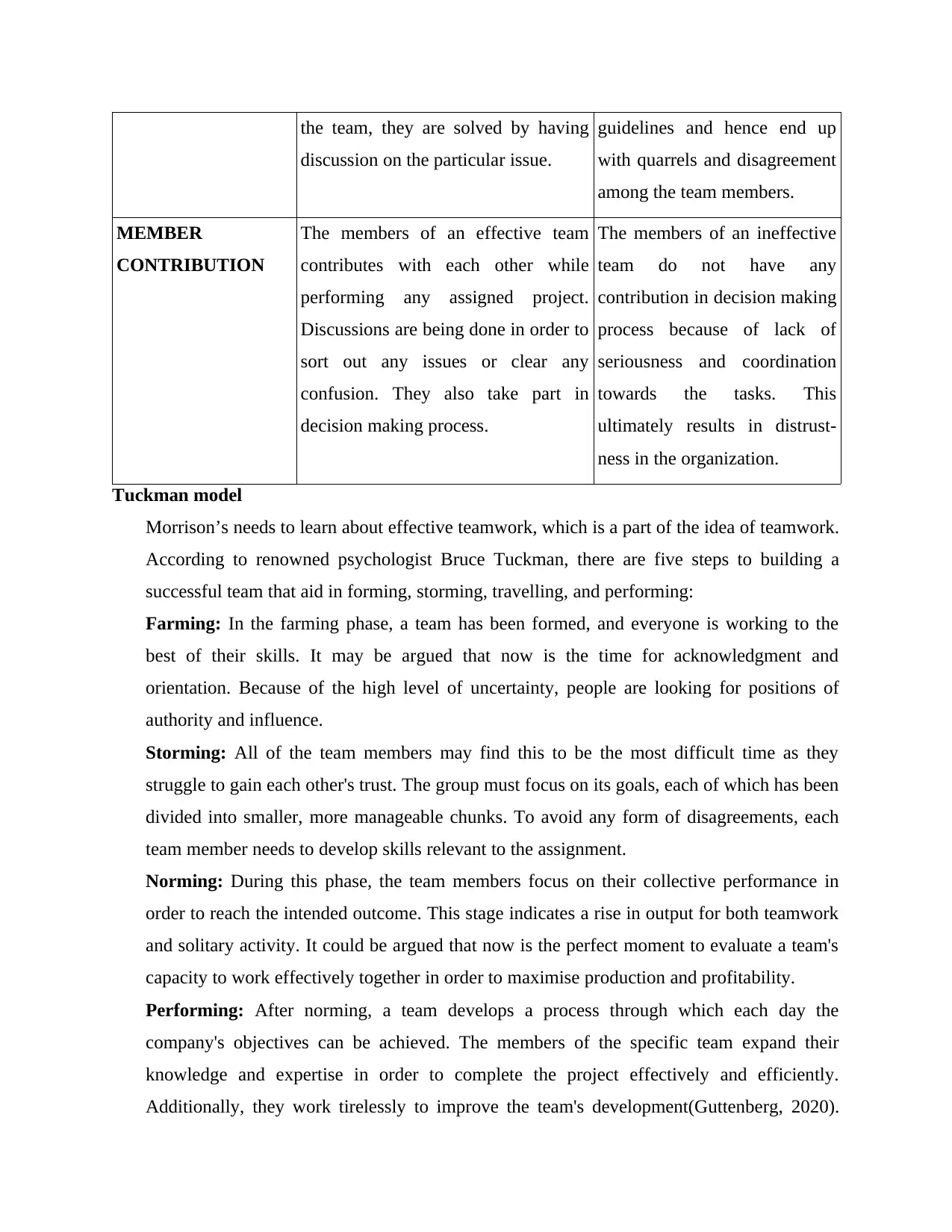
the team, they are solved by having
discussion on the particular issue.
guidelines and hence end up
with quarrels and disagreement
among the team members.
MEMBER
CONTRIBUTION
The members of an effective team
contributes with each other while
performing any assigned project.
Discussions are being done in order to
sort out any issues or clear any
confusion. They also take part in
decision making process.
The members of an ineffective
team do not have any
contribution in decision making
process because of lack of
seriousness and coordination
towards the tasks. This
ultimately results in distrust-
ness in the organization.
Tuckman model
Morrison’s needs to learn about effective teamwork, which is a part of the idea of teamwork.
According to renowned psychologist Bruce Tuckman, there are five steps to building a
successful team that aid in forming, storming, travelling, and performing:
Farming: In the farming phase, a team has been formed, and everyone is working to the
best of their skills. It may be argued that now is the time for acknowledgment and
orientation. Because of the high level of uncertainty, people are looking for positions of
authority and influence.
Storming: All of the team members may find this to be the most difficult time as they
struggle to gain each other's trust. The group must focus on its goals, each of which has been
divided into smaller, more manageable chunks. To avoid any form of disagreements, each
team member needs to develop skills relevant to the assignment.
Norming: During this phase, the team members focus on their collective performance in
order to reach the intended outcome. This stage indicates a rise in output for both teamwork
and solitary activity. It could be argued that now is the perfect moment to evaluate a team's
capacity to work effectively together in order to maximise production and profitability.
Performing: After norming, a team develops a process through which each day the
company's objectives can be achieved. The members of the specific team expand their
knowledge and expertise in order to complete the project effectively and efficiently.
Additionally, they work tirelessly to improve the team's development(Guttenberg, 2020).
discussion on the particular issue.
guidelines and hence end up
with quarrels and disagreement
among the team members.
MEMBER
CONTRIBUTION
The members of an effective team
contributes with each other while
performing any assigned project.
Discussions are being done in order to
sort out any issues or clear any
confusion. They also take part in
decision making process.
The members of an ineffective
team do not have any
contribution in decision making
process because of lack of
seriousness and coordination
towards the tasks. This
ultimately results in distrust-
ness in the organization.
Tuckman model
Morrison’s needs to learn about effective teamwork, which is a part of the idea of teamwork.
According to renowned psychologist Bruce Tuckman, there are five steps to building a
successful team that aid in forming, storming, travelling, and performing:
Farming: In the farming phase, a team has been formed, and everyone is working to the
best of their skills. It may be argued that now is the time for acknowledgment and
orientation. Because of the high level of uncertainty, people are looking for positions of
authority and influence.
Storming: All of the team members may find this to be the most difficult time as they
struggle to gain each other's trust. The group must focus on its goals, each of which has been
divided into smaller, more manageable chunks. To avoid any form of disagreements, each
team member needs to develop skills relevant to the assignment.
Norming: During this phase, the team members focus on their collective performance in
order to reach the intended outcome. This stage indicates a rise in output for both teamwork
and solitary activity. It could be argued that now is the perfect moment to evaluate a team's
capacity to work effectively together in order to maximise production and profitability.
Performing: After norming, a team develops a process through which each day the
company's objectives can be achieved. The members of the specific team expand their
knowledge and expertise in order to complete the project effectively and efficiently.
Additionally, they work tirelessly to improve the team's development(Guttenberg, 2020).
⊘ This is a preview!⊘
Do you want full access?
Subscribe today to unlock all pages.

Trusted by 1+ million students worldwide
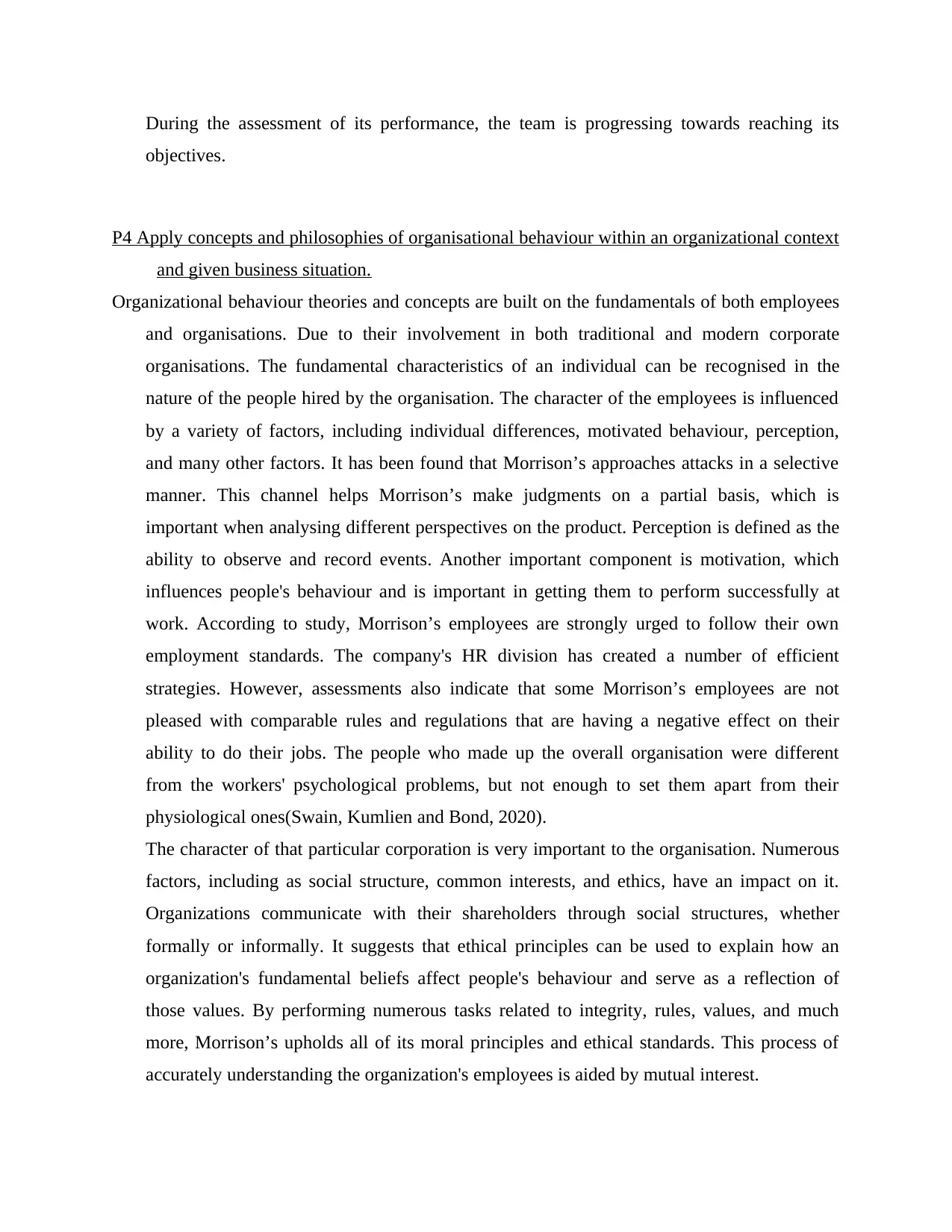
During the assessment of its performance, the team is progressing towards reaching its
objectives.
P4 Apply concepts and philosophies of organisational behaviour within an organizational context
and given business situation.
Organizational behaviour theories and concepts are built on the fundamentals of both employees
and organisations. Due to their involvement in both traditional and modern corporate
organisations. The fundamental characteristics of an individual can be recognised in the
nature of the people hired by the organisation. The character of the employees is influenced
by a variety of factors, including individual differences, motivated behaviour, perception,
and many other factors. It has been found that Morrison’s approaches attacks in a selective
manner. This channel helps Morrison’s make judgments on a partial basis, which is
important when analysing different perspectives on the product. Perception is defined as the
ability to observe and record events. Another important component is motivation, which
influences people's behaviour and is important in getting them to perform successfully at
work. According to study, Morrison’s employees are strongly urged to follow their own
employment standards. The company's HR division has created a number of efficient
strategies. However, assessments also indicate that some Morrison’s employees are not
pleased with comparable rules and regulations that are having a negative effect on their
ability to do their jobs. The people who made up the overall organisation were different
from the workers' psychological problems, but not enough to set them apart from their
physiological ones(Swain, Kumlien and Bond, 2020).
The character of that particular corporation is very important to the organisation. Numerous
factors, including as social structure, common interests, and ethics, have an impact on it.
Organizations communicate with their shareholders through social structures, whether
formally or informally. It suggests that ethical principles can be used to explain how an
organization's fundamental beliefs affect people's behaviour and serve as a reflection of
those values. By performing numerous tasks related to integrity, rules, values, and much
more, Morrison’s upholds all of its moral principles and ethical standards. This process of
accurately understanding the organization's employees is aided by mutual interest.
objectives.
P4 Apply concepts and philosophies of organisational behaviour within an organizational context
and given business situation.
Organizational behaviour theories and concepts are built on the fundamentals of both employees
and organisations. Due to their involvement in both traditional and modern corporate
organisations. The fundamental characteristics of an individual can be recognised in the
nature of the people hired by the organisation. The character of the employees is influenced
by a variety of factors, including individual differences, motivated behaviour, perception,
and many other factors. It has been found that Morrison’s approaches attacks in a selective
manner. This channel helps Morrison’s make judgments on a partial basis, which is
important when analysing different perspectives on the product. Perception is defined as the
ability to observe and record events. Another important component is motivation, which
influences people's behaviour and is important in getting them to perform successfully at
work. According to study, Morrison’s employees are strongly urged to follow their own
employment standards. The company's HR division has created a number of efficient
strategies. However, assessments also indicate that some Morrison’s employees are not
pleased with comparable rules and regulations that are having a negative effect on their
ability to do their jobs. The people who made up the overall organisation were different
from the workers' psychological problems, but not enough to set them apart from their
physiological ones(Swain, Kumlien and Bond, 2020).
The character of that particular corporation is very important to the organisation. Numerous
factors, including as social structure, common interests, and ethics, have an impact on it.
Organizations communicate with their shareholders through social structures, whether
formally or informally. It suggests that ethical principles can be used to explain how an
organization's fundamental beliefs affect people's behaviour and serve as a reflection of
those values. By performing numerous tasks related to integrity, rules, values, and much
more, Morrison’s upholds all of its moral principles and ethical standards. This process of
accurately understanding the organization's employees is aided by mutual interest.
Paraphrase This Document
Need a fresh take? Get an instant paraphrase of this document with our AI Paraphraser
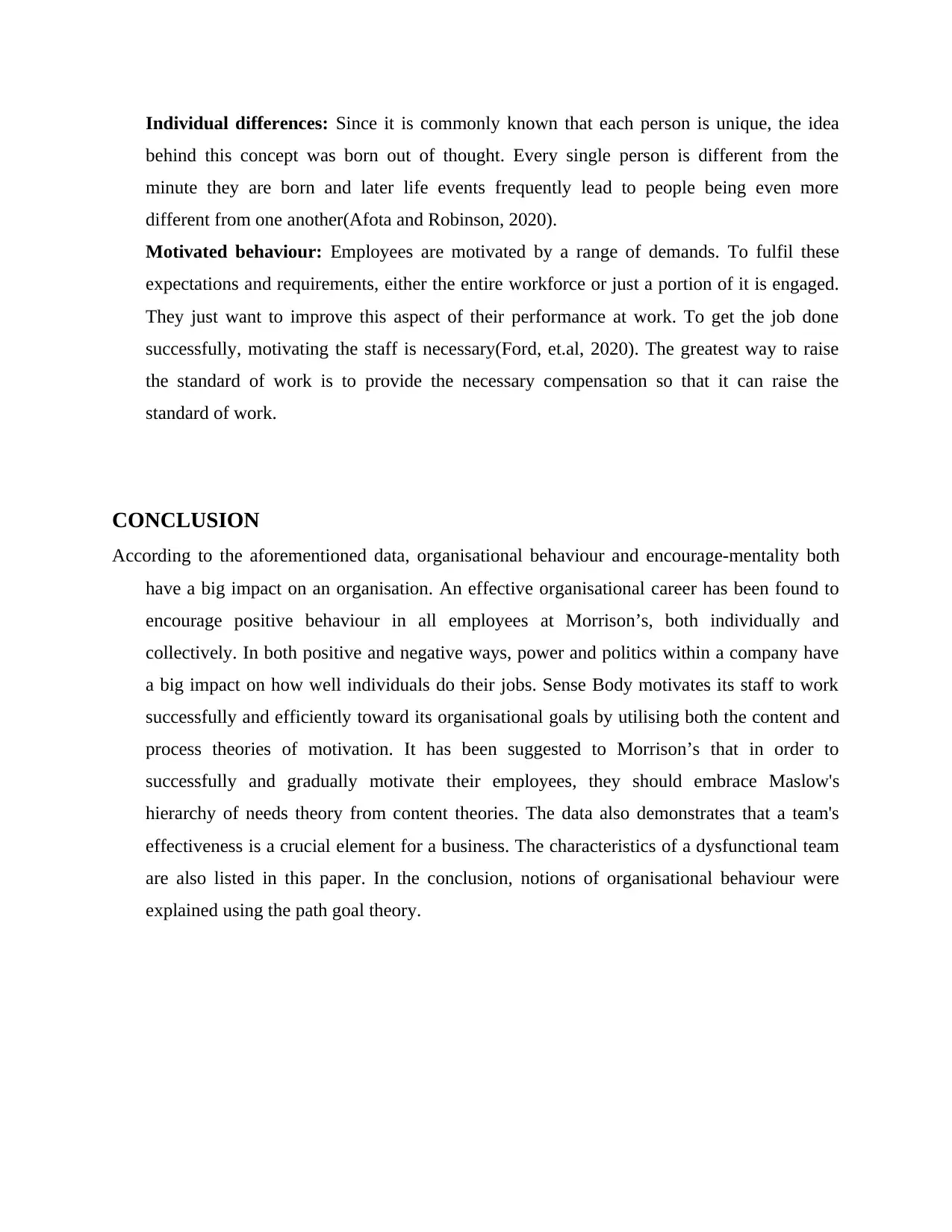
Individual differences: Since it is commonly known that each person is unique, the idea
behind this concept was born out of thought. Every single person is different from the
minute they are born and later life events frequently lead to people being even more
different from one another(Afota and Robinson, 2020).
Motivated behaviour: Employees are motivated by a range of demands. To fulfil these
expectations and requirements, either the entire workforce or just a portion of it is engaged.
They just want to improve this aspect of their performance at work. To get the job done
successfully, motivating the staff is necessary(Ford, et.al, 2020). The greatest way to raise
the standard of work is to provide the necessary compensation so that it can raise the
standard of work.
CONCLUSION
According to the aforementioned data, organisational behaviour and encourage-mentality both
have a big impact on an organisation. An effective organisational career has been found to
encourage positive behaviour in all employees at Morrison’s, both individually and
collectively. In both positive and negative ways, power and politics within a company have
a big impact on how well individuals do their jobs. Sense Body motivates its staff to work
successfully and efficiently toward its organisational goals by utilising both the content and
process theories of motivation. It has been suggested to Morrison’s that in order to
successfully and gradually motivate their employees, they should embrace Maslow's
hierarchy of needs theory from content theories. The data also demonstrates that a team's
effectiveness is a crucial element for a business. The characteristics of a dysfunctional team
are also listed in this paper. In the conclusion, notions of organisational behaviour were
explained using the path goal theory.
behind this concept was born out of thought. Every single person is different from the
minute they are born and later life events frequently lead to people being even more
different from one another(Afota and Robinson, 2020).
Motivated behaviour: Employees are motivated by a range of demands. To fulfil these
expectations and requirements, either the entire workforce or just a portion of it is engaged.
They just want to improve this aspect of their performance at work. To get the job done
successfully, motivating the staff is necessary(Ford, et.al, 2020). The greatest way to raise
the standard of work is to provide the necessary compensation so that it can raise the
standard of work.
CONCLUSION
According to the aforementioned data, organisational behaviour and encourage-mentality both
have a big impact on an organisation. An effective organisational career has been found to
encourage positive behaviour in all employees at Morrison’s, both individually and
collectively. In both positive and negative ways, power and politics within a company have
a big impact on how well individuals do their jobs. Sense Body motivates its staff to work
successfully and efficiently toward its organisational goals by utilising both the content and
process theories of motivation. It has been suggested to Morrison’s that in order to
successfully and gradually motivate their employees, they should embrace Maslow's
hierarchy of needs theory from content theories. The data also demonstrates that a team's
effectiveness is a crucial element for a business. The characteristics of a dysfunctional team
are also listed in this paper. In the conclusion, notions of organisational behaviour were
explained using the path goal theory.
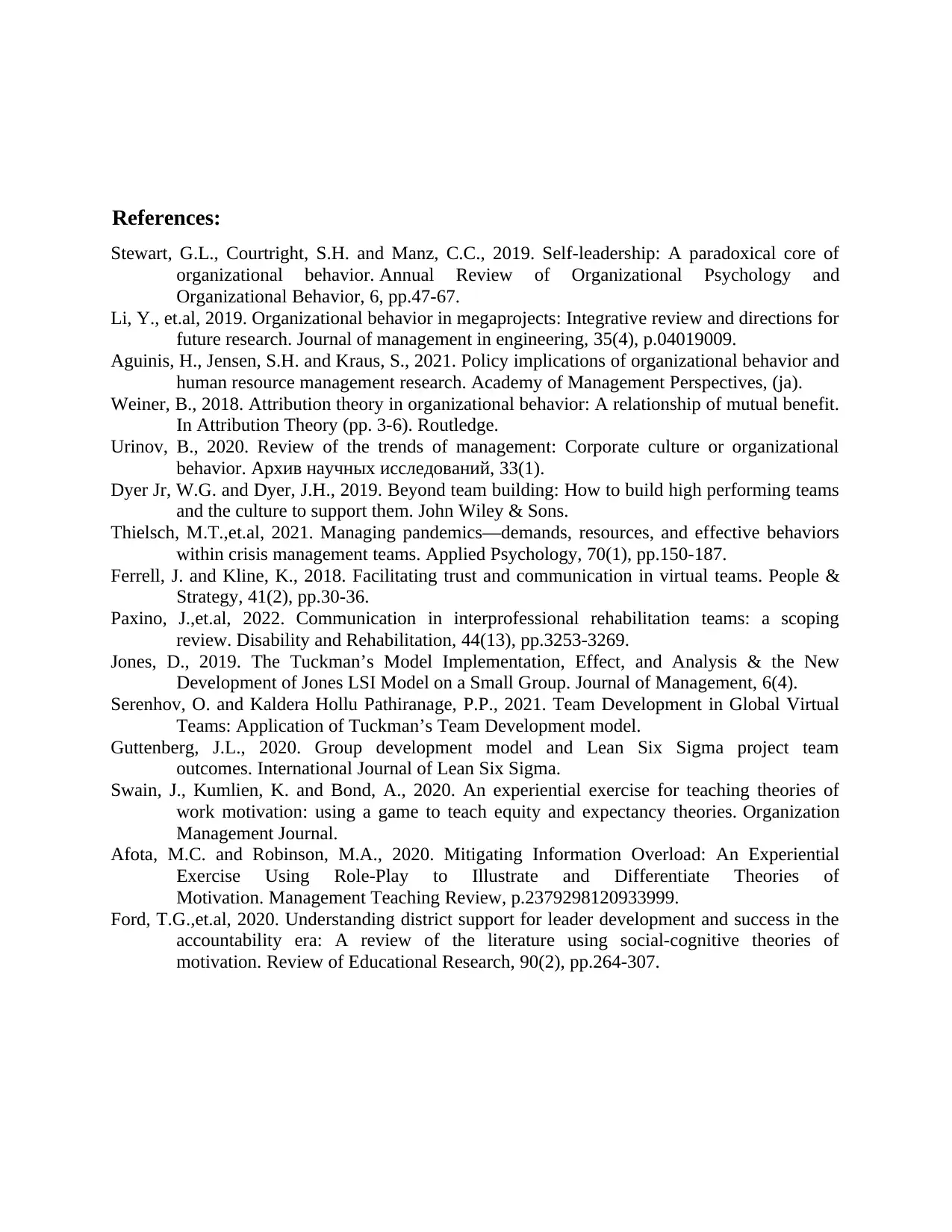
References:
Stewart, G.L., Courtright, S.H. and Manz, C.C., 2019. Self-leadership: A paradoxical core of
organizational behavior. Annual Review of Organizational Psychology and
Organizational Behavior, 6, pp.47-67.
Li, Y., et.al, 2019. Organizational behavior in megaprojects: Integrative review and directions for
future research. Journal of management in engineering, 35(4), p.04019009.
Aguinis, H., Jensen, S.H. and Kraus, S., 2021. Policy implications of organizational behavior and
human resource management research. Academy of Management Perspectives, (ja).
Weiner, B., 2018. Attribution theory in organizational behavior: A relationship of mutual benefit.
In Attribution Theory (pp. 3-6). Routledge.
Urinov, B., 2020. Review of the trends of management: Corporate culture or organizational
behavior. Архив научных исследований, 33(1).
Dyer Jr, W.G. and Dyer, J.H., 2019. Beyond team building: How to build high performing teams
and the culture to support them. John Wiley & Sons.
Thielsch, M.T.,et.al, 2021. Managing pandemics—demands, resources, and effective behaviors
within crisis management teams. Applied Psychology, 70(1), pp.150-187.
Ferrell, J. and Kline, K., 2018. Facilitating trust and communication in virtual teams. People &
Strategy, 41(2), pp.30-36.
Paxino, J.,et.al, 2022. Communication in interprofessional rehabilitation teams: a scoping
review. Disability and Rehabilitation, 44(13), pp.3253-3269.
Jones, D., 2019. The Tuckman’s Model Implementation, Effect, and Analysis & the New
Development of Jones LSI Model on a Small Group. Journal of Management, 6(4).
Serenhov, O. and Kaldera Hollu Pathiranage, P.P., 2021. Team Development in Global Virtual
Teams: Application of Tuckman’s Team Development model.
Guttenberg, J.L., 2020. Group development model and Lean Six Sigma project team
outcomes. International Journal of Lean Six Sigma.
Swain, J., Kumlien, K. and Bond, A., 2020. An experiential exercise for teaching theories of
work motivation: using a game to teach equity and expectancy theories. Organization
Management Journal.
Afota, M.C. and Robinson, M.A., 2020. Mitigating Information Overload: An Experiential
Exercise Using Role-Play to Illustrate and Differentiate Theories of
Motivation. Management Teaching Review, p.2379298120933999.
Ford, T.G.,et.al, 2020. Understanding district support for leader development and success in the
accountability era: A review of the literature using social-cognitive theories of
motivation. Review of Educational Research, 90(2), pp.264-307.
Stewart, G.L., Courtright, S.H. and Manz, C.C., 2019. Self-leadership: A paradoxical core of
organizational behavior. Annual Review of Organizational Psychology and
Organizational Behavior, 6, pp.47-67.
Li, Y., et.al, 2019. Organizational behavior in megaprojects: Integrative review and directions for
future research. Journal of management in engineering, 35(4), p.04019009.
Aguinis, H., Jensen, S.H. and Kraus, S., 2021. Policy implications of organizational behavior and
human resource management research. Academy of Management Perspectives, (ja).
Weiner, B., 2018. Attribution theory in organizational behavior: A relationship of mutual benefit.
In Attribution Theory (pp. 3-6). Routledge.
Urinov, B., 2020. Review of the trends of management: Corporate culture or organizational
behavior. Архив научных исследований, 33(1).
Dyer Jr, W.G. and Dyer, J.H., 2019. Beyond team building: How to build high performing teams
and the culture to support them. John Wiley & Sons.
Thielsch, M.T.,et.al, 2021. Managing pandemics—demands, resources, and effective behaviors
within crisis management teams. Applied Psychology, 70(1), pp.150-187.
Ferrell, J. and Kline, K., 2018. Facilitating trust and communication in virtual teams. People &
Strategy, 41(2), pp.30-36.
Paxino, J.,et.al, 2022. Communication in interprofessional rehabilitation teams: a scoping
review. Disability and Rehabilitation, 44(13), pp.3253-3269.
Jones, D., 2019. The Tuckman’s Model Implementation, Effect, and Analysis & the New
Development of Jones LSI Model on a Small Group. Journal of Management, 6(4).
Serenhov, O. and Kaldera Hollu Pathiranage, P.P., 2021. Team Development in Global Virtual
Teams: Application of Tuckman’s Team Development model.
Guttenberg, J.L., 2020. Group development model and Lean Six Sigma project team
outcomes. International Journal of Lean Six Sigma.
Swain, J., Kumlien, K. and Bond, A., 2020. An experiential exercise for teaching theories of
work motivation: using a game to teach equity and expectancy theories. Organization
Management Journal.
Afota, M.C. and Robinson, M.A., 2020. Mitigating Information Overload: An Experiential
Exercise Using Role-Play to Illustrate and Differentiate Theories of
Motivation. Management Teaching Review, p.2379298120933999.
Ford, T.G.,et.al, 2020. Understanding district support for leader development and success in the
accountability era: A review of the literature using social-cognitive theories of
motivation. Review of Educational Research, 90(2), pp.264-307.
⊘ This is a preview!⊘
Do you want full access?
Subscribe today to unlock all pages.

Trusted by 1+ million students worldwide
1 out of 12
Related Documents
Your All-in-One AI-Powered Toolkit for Academic Success.
+13062052269
info@desklib.com
Available 24*7 on WhatsApp / Email
![[object Object]](/_next/static/media/star-bottom.7253800d.svg)
Unlock your academic potential
Copyright © 2020–2025 A2Z Services. All Rights Reserved. Developed and managed by ZUCOL.




